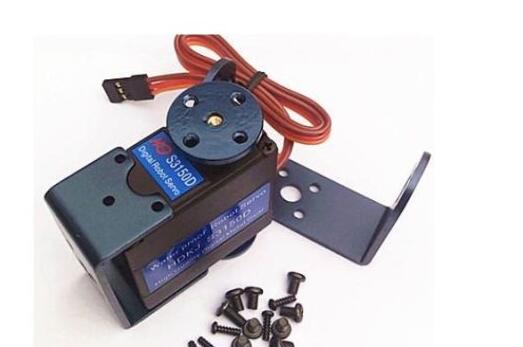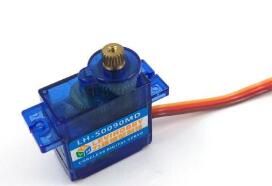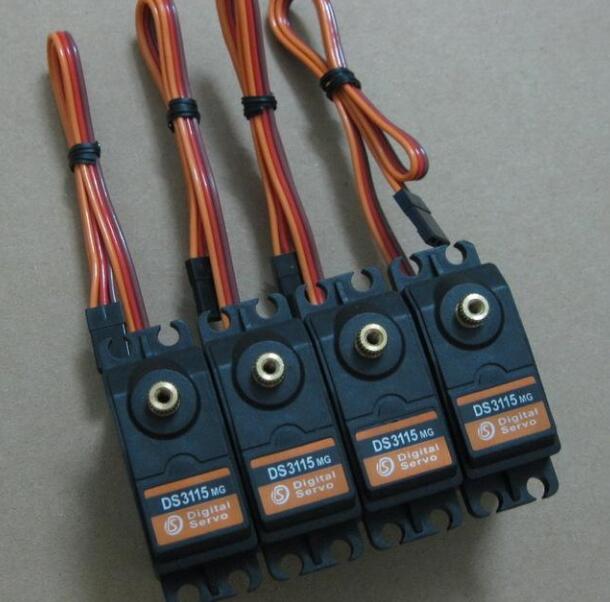Digital Servo and Analog Servo are identical in terms of basic mechanical structure. They are mainly composed of motors, reduction gears and control circuits. The biggest difference between digital servos and analog servos is Embodied in the control circuit, the digital steering gear's control circuit has more microprocessors and crystals than analog servos. Do not underestimate this change, it has a decisive influence on improving the performance of the servo.
Digital servo control principleThe control signal enters the signal modulation chip from the receiver's channel to obtain the DC bias voltage. It has a reference circuit internally, generates a reference signal with a period of 20ms and a width of 1.5ms, and compares the obtained DC bias voltage with the voltage of the potentiometer to obtain a voltage difference output. Finally, the positive and negative voltage difference is output to the motor driver chip to determine the positive and negative motor rotation. When the motor speed is constant, the potentiometer is rotated through the cascade reduction gear, so that the voltage difference is 0, and the motor stops rotating. Of course, we don't need to understand its specific working principle. We know that its control principle is enough. Just as we use transistors, we know that we can use it as a switch or amplifying tube. As for the specific flow of electrons in a tube, it can be completely ignored.

Advantage
1. Because of the relationship of the microprocessor, the digital servo can process the input signal according to the set parameters before sending the power pulse to the servo motor. This means that the width of the power pulse, that is, the power to excite the motor, can be adjusted according to the microprocessor's program calculations to adapt to different functional requirements and optimize the performance of the servo.
2. The digital servo sends power pulses to the motor at a much higher frequency. That is, relative to the conventional 50 pulses/sec, it is now 300 pulses/sec. Although, in a high-frequency relationship, the width of each power pulse is reduced, the motor receives more excitation signals at the same time and rotates faster. This also means that not only does the servo motor respond to the transmitter's signal at a higher frequency, but the "no response zone" gets smaller; the response becomes faster; the acceleration and deceleration are also faster and softer; the digital servo provides Higher accuracy and better fixed strength.
Shortcomings
1. Digital servos need to consume more power. In fact, this is very natural. Digital servos modify the motor at higher frequencies, which will definitely increase the overall power consumption.
2, relatively short life span. In fact, this is very natural. The motor is always turning to make corrections, which will definitely increase the consumption of the motor and other rotating parts.

1. Digital servos are higher in position accuracy than analog servos.
2. In the face of the same nominal 1.6 kg servo, the digital servo will feel even more "strength and strength" in the actual performance and the analog steering gear will be "meat".
3. Analog servo As the control chip is an analog circuit, even if the same type of rudder has a small performance difference, the digital servo is very good in consistency.
4. Digital servos generally use the PID optimization algorithm, so the linearity is better than the analog steering gear.
5. For high-sensitivity control, it is recommended to choose a digital servo, such as helicopter control, high-speed fixed-wing aircraft, high-speed gliders, race car film, PTZ control, etc.
6. For applications where sensitivity is not particularly needed, such as low-speed fixed-wing aircraft (World War II aircraft, exercise machines, low-speed gliders, etc.), boat models, and recreational vehicle models. Can consider analog steering gear.

Many die friends mistakenly believe that: "The digital servo's PWM drive frequency 300Hz is 6 times higher than the analog servo's 50Hz, and the servo motor speed is 6 times faster, so the digital servo's response speed is 6 times faster than the analog servo'." . Here, please pay attention to the concept of duty cycle, the pulse width is the effective level time per cycle, and the duty cycle is the percentage of the pulse width/cycle, so the size is independent of the frequency. The duty cycle determines the voltage applied to the motor. When the load torque is constant, the motor speed is determined, regardless of the PWM frequency.
Analog servo is a DC servo motor controller chip can only receive PWM external control signal of about 50Hz frequency (period 20ms) ~300Hz, too high frequency will not work. If the PWM external control signal is 50Hz, the resolution time of the position information obtained by the controller chip of the DC servo motor is 20ms, and the difference between the proportional voltage of the PWM control signal and the voltage of the feedback potentiometer is obtained, and the difference is expanded by the pulse width (occupied The air-to-air ratio changes, and the size changes proportionally to the difference.) The drive motor is then actuated. This means that due to the frequency limitation of the PWM external control signal, a new adjustment of the servo rocker arm position can be made as fast as 20 ms.
The digital servo can receive the PWM external control signal much faster than the 50Hz frequency (20ms period) through the MCU, and the position information of the PWM external control signal can be distinguished in a shorter time, and the voltage proportional to the duty ratio of the PWM signal is calculated. The difference between the voltage of the feedback potentiometer and the voltage of the feedback potentiometer is used to drive the motor to perform the latest adjustment of the position of the rocker arm of the servo.
Conclusion: Regardless of analog or digital servos, when the load torque is constant, the motor speed depends on the duty ratio of the drive signal and is independent of the frequency. The digital servo can receive higher frequency PWM external control signals, can obtain position information after a shorter cycle time, and make latest adjustments to the position of the servo rocker arm. Therefore, the speed response of the digital servo is faster than that of the analog servo, rather than the speed of the drive motor is faster than that of the analog servo.
Why is the range of the non-reaction area of ​​a digital servo smaller than that of an analog steering gear?According to the above analysis of the analog servo, it can be seen that the analog servo can take about 20ms to make a new adjustment. The digital servo drives the motor with a higher frequency PWM. The increase of PWM frequency makes the motor start/stop, acceleration/deceleration more gentle, smoother, and more effective to provide the motor with the torque required for starting. Just as the car gets a smaller throttle control range, it starts/stops and the acceleration/deceleration performance is better. Therefore, the non-reaction area of ​​the digital servo is smaller than that of the analog servo.
China leading manufacturers and suppliers of DC Support Capacitors,DC Capacitor, and we are specialize in Electrolytic capacitor,High Voltage Capacitor, etc.DC Support Capacitors
DC Support Capacitors,DC Capacitor,Electrolytic Capacitor,High Voltage Capacitor
YANGZHOU POSITIONING TECH CO., LTD. , https://www.cnchipmicro.com